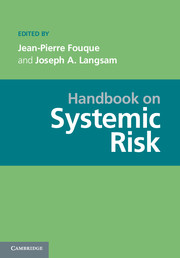Book contents
- Frontmatter
- Contents
- Contributors
- Introduction
- PART I DATA: THE PREREQUISITE FOR MANAGING SYSTEMIC RISK
- PART II STATISTICS AND SYSTEMIC RISK
- PART III MEASURING AND REGULATING SYSTEMIC RISK
- PART IV NETWORKS
- PART V SYSTEMIC RISK ANDMATHEMATICAL FINANCE
- PART VI COUNTERPARTY RISK AND SYSTEMIC RISK
- 19 Pricing and Mitigation of Counterparty Credit Exposures
- 20 Counterparty Contagion in Context: Contributions to Systemic Risk
- PART VII ALGORITHMIC TRADING
- PART VIII BEHAVIORAL FINANCE: THE PSYCHOLOGICAL DIMENSION OF SYSTEMIC RISK
- PART IX REGULATION
- PART X COMPUTATIONAL ISSUES AND REQUIREMENTS
- PART XI ACCOUNTING ISSUES
- References
19 - Pricing and Mitigation of Counterparty Credit Exposures
from PART VI - COUNTERPARTY RISK AND SYSTEMIC RISK
Published online by Cambridge University Press: 05 June 2013
- Frontmatter
- Contents
- Contributors
- Introduction
- PART I DATA: THE PREREQUISITE FOR MANAGING SYSTEMIC RISK
- PART II STATISTICS AND SYSTEMIC RISK
- PART III MEASURING AND REGULATING SYSTEMIC RISK
- PART IV NETWORKS
- PART V SYSTEMIC RISK ANDMATHEMATICAL FINANCE
- PART VI COUNTERPARTY RISK AND SYSTEMIC RISK
- 19 Pricing and Mitigation of Counterparty Credit Exposures
- 20 Counterparty Contagion in Context: Contributions to Systemic Risk
- PART VII ALGORITHMIC TRADING
- PART VIII BEHAVIORAL FINANCE: THE PSYCHOLOGICAL DIMENSION OF SYSTEMIC RISK
- PART IX REGULATION
- PART X COMPUTATIONAL ISSUES AND REQUIREMENTS
- PART XI ACCOUNTING ISSUES
- References
Summary
Abstract We analyze the market price of counterparty risk and develop an arbitrage-free pricing valuation framework, inclusive of collateral mitigation. We show that the adjustment is given by the sum of option payoff terms, depending on the netted exposure, i.e. the difference between the on-default exposure and the predefault collateral account. We specialize our analysis to Interest Rates Swaps (IRS) and Credit Default Swaps (CDS) as underlying portfolio, and perform a numerical study to illustrate the impact of default correlation, collateral margining frequency, and collateral re-hypothecation on the resulting adjustment. We also discuss problems of current research interest in the counterparty risk community.
Keywords Counterparty Risk, Systemic Risk, Credit Default Swaps, Interest Rates Swaps, Default Correlation, Stochastic Intensity, Collateral Margining. AMS Classification Codes: 60H10, 60J60, 60J75, 62H20, 91B70. JEL Classification Codes: C15, C63, C65, G12, G13.
Introduction
Basel II defines the counterparty credit risk as the amount that a financial institution would lose in the event that one of its counterparties defaults before the final settlement of the transaction. Unlike a firm's exposure to credit risk through a loan, where the exposure to credit risk is unilateral and only the lending bank faces the risk of loss, the counterparty credit risk creates a bilateral risk of loss, when both parties are default sensitive. Such risk is embedded in all financial contracts which are traded over the counter, where the credit quality of counterparties plays a key role.
- Type
- Chapter
- Information
- Handbook on Systemic Risk , pp. 485 - 511Publisher: Cambridge University PressPrint publication year: 2013
References
- 11
- Cited by

